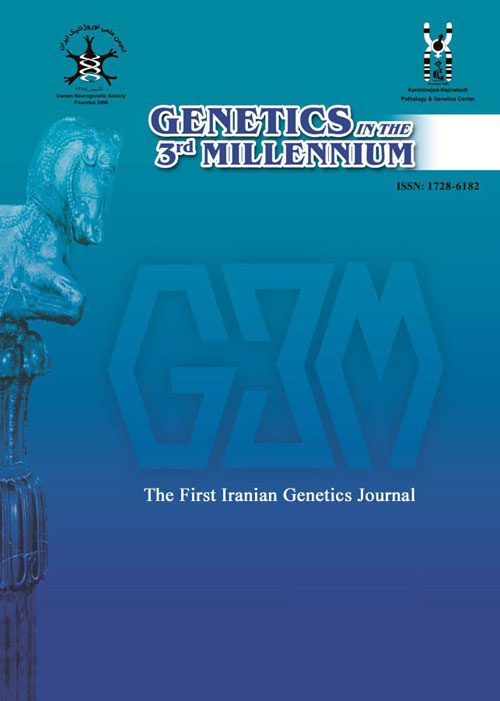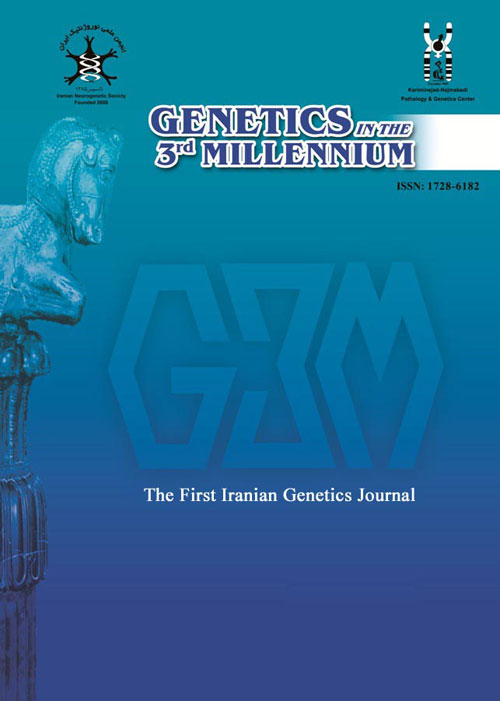فهرست مطالب

Genetics in the Third Millennium
Volume:14 Issue: 3, Summer 2016
- تاریخ انتشار: 1395/07/20
- تعداد عناوین: 6
-
-
Pages 4300-4302The main disorder are due to sex chromosomal aberration comprising 2644(82.5%), cases ranging from 1211 klinefelter followed by 1025 Turner syndrome, 345 triple X, 49 double Y and 14 cases of XX male. The second group consists 116 cases of gonadal dysgenesis bearing 0.042 risk of malignant transformation for XY gonadal dysgenesis. The 3rd group is hormonal defects consisting 29 cases of congenital adrenal hyperplasia followed by 50 cases of androgen insensitivity eight cases of 5α reducture deficiency and 3 cases of persistent Mullerian duct, which one of them is a 27 well grown up man uterine hernia with good fertility, probably the unic cases of such condition that have been reported in the literature sofar there are also 36 cases of true hermaphroditeKeywords: Disorders of Sex Development, Sexual Differentiation, Sexual Ambiguity, Hermaphroditism
-
Pages 4304-4309Recurrent pregnancy loss (RPL) is a multifactorial disorder that remains idiopathic in 50% of the cases. The aim of this study was to investigate the association between MTHFD1 as well as eNOS polymorphisms with idiopathic RPL. In a case-control study, 100 women with idiopathic recurrent pregnancy loss (PRL) and 50 controls referred to Noor Laboratory, Khoozestan, Iran, were evaluated. Genotyping of eNOSG894T and MTHFD1 G1958A variants was performed by polymerase chain reactionrestriction fragment length polymorphism (PCR-RFLP) analysis. Results were compared between the two groups. The allele and genotype frequency of MTHFD1 G1958A variant as well as the allele frequency of eNOSG894G were not significantly different between the two groups while eNOSG894T genotype was significantly different between idiopathic RPL group and controls. Endothelial NOS G894T heterozygous (GT) genotype caused a 2.82 fold increase in the risk of idiopathic RPL compared to GG genotype. eNOS G894T variant is significantly associated with the risk of idiopathic RPL while there is no such association for MTHFD1 G1958A variant in the Iranian population.Keywords: eNOS, MTHFD1, Polymorphism, Genetic, Idiopathic Recurrent Pregnancy Loss
-
Pages 4310-4317Breast cancer is the most important and prevalent cancer in women that can be managed if detected in the early stages. Recently, there has been much focus on the use of epigenetic changes such as DNA methylation in early detection of cancer. As recent research has put forth DOK7 CpG Island methylation as an epimarker, in the present study, using a quantification method, a cohort of Iranian sporadic breast cancer patients are studied compared to healthy women. In this matched case-control study (by ethnicity andage), blood samples were collected and the extracted DNA was controlled and after sonication, the MeDIP process started. The enrichment estimation is the MeDIP control step and after that, all of the H19-ICR, GAPDH-promoter and DOK7-CpG were standardized with appropriate efficiency for Real-Time PCR relative quantification process. Comparison of the Relative Quantification (RQ) of the enriched methylated DNA in the DOK7 gene CpG island in the two groups showed a significant difference (P=0.01). The mean RQ was 0.961 (0.91) in patients and 0.44 (0.46) in the control group. The ROC curve analysis showed AUC= 0.671 and the estimated cut-off for this gene RQ was 1.136; in this cut-off, the odd sratio (OR) was 4.773 (95% CI; 1.52-14.98). It should be noted that the methylation level for DOK7-CpG in DCIS was significantly higher than ICD patients (P-Value= 0.023). Based on our results, we conclude that increased levels of DNA methylation in the DOK7-CpG in peripheral leukocyte associate with breast cancer and after further studies, it can be used as an early diagnostic indicator or a biomarker for breast cancer susceptibility.Keywords: Breast Cancer, Biomarkers, Early Detection of Cancer, DOK7 Gene
-
Pages 4318-4322Turnip curly top virus (TCTV) is a member of the newly established genus Turncurtovirus, family Geminiviridae. Development of an efficient detection system is necessary to study the biological characteristics of viruses. Due to the superior efficacy of the serological methods for detection of plant viruses, in this research, with the aim to facilitate the process of immunological detection of TCTV, coat protein (CP) gene of the virus was sub-cloned into prokaryotic expression vector pQE-60 and transferred into E. coli strain M15. Following induction of CP expression, total protein was extracted and run onto 12.5% SDS-PAGE. An approximate 34 kDa band corresponding to the TCTV CP has been expressed in the prokaryotic host. This protein could be used as antigen to induce the antibody generation for the serological detection of TCTV.Keywords: Capsid Protein, Turnip Curly Top Virus, Cloning, Esherichia Coli, Geminiviridae
-
Pages 4324-4331Diacylglycerol acyltransferase1 (DGAT1) has been introduced as a strong potential candidate gene for milk fat content in cattle. DGAT1 gene plays a key role in the final step of triglyceride synthesis. In this study, the genetic variability in the region spanning exon 1 to exon 2 of the buffalo DGAT1 gene was investigated by DNA sequencing. Two hundred buffaloes belonging to three indigenous populations (Khuzestani, Shomali and Azari) were analyzed. No polymorphisms or mutations were found within the coding region of the DGAT1 gene. Analysis of the non-coding region (1935 bp) revealed the identification of eight SNPs located in intron 1 at nucleotide positions g.1701C>T, g.3097C>T, g.3542G>A, g.3627C>T, g.3674G>A, g.3738C>T, g.3741G>C and g.3815C>A, four of which were novel in compare to the reference sequence. High diversity SNPs found at nucleotide positions g.1701C>T, g.3674G>A and g.3815C>A, which displayed intermediate frequencies in the studied population. These findings suggest that detected allele variations might be considered in marker-assisted selection of milk production traits in buffalo.Keywords: DGAT1 Gene, SNPs, Iranian Buffalo, Genotyping, Milk Production, Composition
-
Page 4332Proteomics has emerged since 1995 for studying the total proteome of cells, tissues, or organisms at any condition. The study of proteins has a fundamental importance because they are the functional and final molecules of the gene expression process and proteomics could be a valuable technique for achieving this purpose. Mass spectrometry is a complementary technique for proteomics that allows us to identify protein spots. In this review, we described all features of gel-based proteomics that include two different methods for separation and identification of protein spots.Keywords: Isoelectric Focusing, SDS, PAGE, Mass Spectrometry


